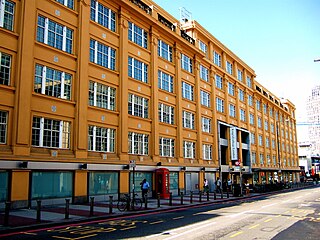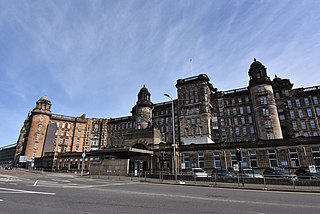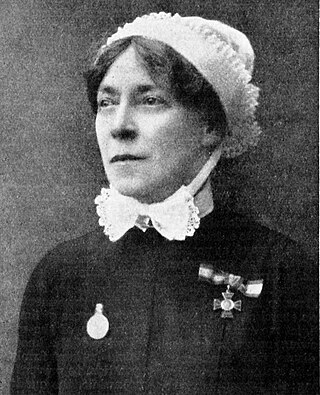
The Royal London Hospital is a large teaching hospital in Whitechapel in the London Borough of Tower Hamlets. It is part of Barts Health NHS Trust. It provides district general hospital services for the City of London and Tower Hamlets and specialist tertiary care services for patients from across London and elsewhere. The current hospital building has 845 beds and 34 wards. It opened in February 2012.

The Florence Nightingale Faculty of Nursing, Midwifery & Palliative Care is an academic faculty within King's College London. The faculty is the world's first nursing school to be continuously connected to a fully serving hospital and medical school. Established on 9 July 1860 by Florence Nightingale, the founder of modern nursing, it was a model for many similar training schools through the UK, Commonwealth and other countries for the latter half of the 19th century. It is primarily concerned with the education of people to become nurses and midwives. It also carries out nursing research, continuing professional development and postgraduate programmes. The Faculty forms part of the Waterloo campus on the South Bank of the River Thames and is now one of the largest faculties in the university.

The Royal National Orthopaedic Hospital (RNOH) is a specialist orthopaedic hospital located in the London Borough of Harrow, United Kingdom, and a part of Royal National Orthopaedic Hospital NHS Trust. It provides the most comprehensive range of neuro-musculoskeletal health care in the UK, including acute spinal injury, complex bone tumour treatment, orthopaedic medicine and specialist rehabilitation for chronic back pain. The RNOH is a major teaching centre and around 20% of orthopaedic surgeons in the UK receive training there.

The Glasgow Royal Infirmary (GRI) is a large teaching hospital. With a capacity of around 1,000 beds, the hospital campus covers an area of around 8 hectares, and straddles the Townhead and Dennistoun districts on the north-eastern fringe of the city centre of Glasgow, Scotland. It is managed by NHS Greater Glasgow and Clyde. It was originally opened in 1794, with the present main building dating from 1914.

The Bristol Royal Infirmary, also known as the BRI, is a large teaching hospital in the centre of Bristol, England. It has links with the nearby University of Bristol and the Faculty of Health and Social Care at the University of the West of England, also in Bristol.

The Radcliffe Infirmary was a hospital in central north Oxford, England, located at the southern end of Woodstock Road on the western side, backing onto Walton Street.
The Queen's Nursing Institute (QNI) is a charity that works to improve the nursing care of people in their own homes in England, Wales, and Northern Ireland. It does not operate in Scotland, where the Queen's Nursing Institute Scotland performs a similar function. The QNI is also affiliated to the Queen's Institute of District Nursing in Ireland. The QNI is a member of the International Council of Nurses.

Westminster Hospital was a hospital in London, England, founded in 1719. In 1834 a medical school attached to the hospital was formally founded. In 1939 a newly built hospital and medical school opened in Horseferry Road, Westminster. In 1994 the hospital closed, and its resources were moved to the new Chelsea and Westminster Hospital at the old St Stephen's Hospital site in Fulham Road.
Theodora Turner, was a British nurse and hospital matron.

Agnes Elizabeth Jones of Fahan, County Donegal, Ireland became the first trained Nursing Superintendent of Liverpool Workhouse Infirmary. She gave all her time and energy to her patients and died at the age of 35 from typhus fever. Florence Nightingale said of Agnes Elizabeth Jones, ‘She overworked as others underwork. I looked upon hers as one of the most valuable lives in England.’

Cromer and District Hospital opened in 1932 in the suburb of Suffield Park in the town of Cromer within the English county of Norfolk. The hospital is run by the Norfolk and Norwich University Hospitals NHS Foundation Trust and provides an important range of acute consultant and nurse-led services to the residents of the district of North Norfolk.
Dame Sarah Elizabeth Oram, became a senior member of the Army Nursing Service (ANS) and Queen Alexandra's Imperial Military Nursing Service (QAIMNS), and served as Principal Matron, Nursing Inspector in the QAIMNS, and was attached to the British Expeditionary Force, France, 1914–1915 and subsequently as Acting Matron-in-Chief, QAIMNS, Eastern Mediterranean Expeditionary Force, 1915–1919 during the First World War.

Eva Charlotte Ellis Luckes was Matron of The London Hospital from 1880 to 1919.

Dame Mary Rosalind Paget, DBE, ARRC, was a noted British nurse, midwife and reformer. She was the first superintendent, later inspector general, of the Queen's Jubilee Institute for District Nursing, which was renamed as the Queen's Institute of District Nursing in 1928 and as the Queen's Nursing Institute in 1973.

The Metropolitan Free Hospital was a London hospital, founded in 1836 and based for most of its existence in Kingsland Road, Hackney. It became part of the NHS in 1948, and closed in 1977, with its residual functions transferring to Barts Hospital.

Isla Stewart was an English hospital matron of St Bartholomew's Hospital in London and a founding member of the Royal British Nurses' Association.

Ethel Anne Priscilla Grenfell, Baroness Desborough was a British society hostess.
Rebecca Strong was an English nurse who pioneered preliminary training for nurses.

Brownlow Hill infirmary was a large workhouse infirmary in Liverpool, notable for its role in advancing training of nurses. The workhouse was demolished in 1931, and the site is now occupied by Liverpool's Catholic cathedral.

Euphemia Steele Innes RRC DN was a Scottish nurse who served for 21 years as matron at Leeds General Infirmary in Leeds, West Riding of Yorkshire, England. She was decorated with the Royal Red Cross 1st class in 1916 for services with the Territorial Force Nursing Service in the First World War.






















